Family name: Rubiaceae Jussieu
Synonym(s): Aparinaceae Hoffmanns. & Link; Asperulaceae Cham. ex Spenn.; Cinchonaceae Batsch; Coffeaceae Batsch; Cynocrambaceae Meisn., nom. illeg.; Dialypetalanthaceae Rizzini & Occhioni, nom. cons.; Galiaceae Lindl.; Gardeniaceae Dumort.; Henriqueziaceae Bremek.; Lippayaceae Meisn.; Lygodisodeaceae Bartl.; Naucleaceae Wernham; Operculariaceae Juss. ex Perleb; Theligonaceae Dumort., nom. cons.
Common name(s): madder family
*Number of genera/species: 631/13,620
List of genera records in GRIN-Global
Fruit usually derived from 2-carpelled gynoecium, often a loculicidalloculicidal:
type of capsular dehiscence, opening longitudinally through the locules (compare septicidal)
 or septicidalsepticidal:
or septicidalsepticidal:
type of capsular dehiscence, opening longitudinally by separating between the septa of adjacent carpels
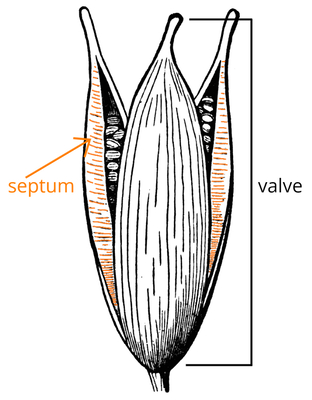 capsulecapsule:
capsulecapsule:
a dry, dehiscent fruit derived from a compound ovary , rarely circumscissilecircumscissile:
, rarely circumscissilecircumscissile:
(~pyxis); type of capsular dehiscence, opens by a lid (splitting transversely)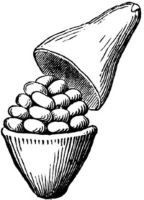 (operculumoperculum:
(operculumoperculum:
a dehiscent cap (or lid) of a seed or fruit that opens during germination or dehiscence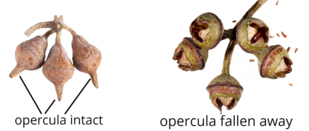 or through apicalapical:
or through apicalapical:
at or pertaining to the end of the seed or fruit distal from its point of attachment (i.e., base)
beak), dentricidal, or ceratium. Or a berry or drupedrupe:
(indehiscent drupe) a fleshy, indehiscent fruit with one more hard pits enclosing seeds, derived from single, superior, simple or compound ovary; (dehiscent drupe) a fruit with a dry or fibrous to fleshy or leathery outer husk that early to tardily breaks apart (or opens), exposing one or more nutlike pits enclosing the seeds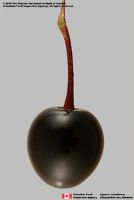 , rarely samarasamara:
, rarely samarasamara:
a winged, indehiscent, dry fruit containing a single (rarely two) seed(s)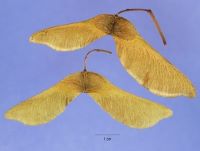 (Allenanthus, Cosmocalyx) or aggregateaggregate:
(Allenanthus, Cosmocalyx) or aggregateaggregate:
fruit formed from a single flower with carpels several and distinct of achenesachene:
of achenesachene:
a dry, indehiscent, one-seeded fruit, with seed attached to pericarp at a single point, derived from a single, superior, simple or compound, one-loculed ovary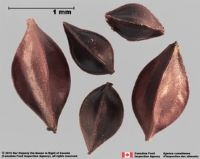 or drupeletsdrupelet:
or drupeletsdrupelet:
one drupe of a fruit with multiple drupes, as in blackberries
sorosissorosis:
a multiple fruit composed of two or more fleshy fruitlets that developed on a peduncle
) e.g. Morinda). DrupesDrupe:
(indehiscent drupe) a fleshy, indehiscent fruit with one more hard pits enclosing seeds, derived from single, superior, simple or compound ovary; (dehiscent drupe) a fruit with a dry or fibrous to fleshy or leathery outer husk that early to tardily breaks apart (or opens), exposing one or more nutlike pits enclosing the seeds with 1–2(–22) pyrenespyrene:
with 1–2(–22) pyrenespyrene:
the hard inner portion of a drupe, consisting of a bony endocarp and an enclosed seed
per drupedrupe:
(indehiscent drupe) a fleshy, indehiscent fruit with one more hard pits enclosing seeds, derived from single, superior, simple or compound ovary; (dehiscent drupe) a fruit with a dry or fibrous to fleshy or leathery outer husk that early to tardily breaks apart (or opens), exposing one or more nutlike pits enclosing the seeds , which often function as disseminules with germination slits. Or a schizocarpschizocarp:
, which often function as disseminules with germination slits. Or a schizocarpschizocarp:
usually dry fruit splitting between two or more locules to form distinct, indehiscent, usually one seeded segments; fruit derived from a single, superior or inferior, compound ovary; compare to mericarp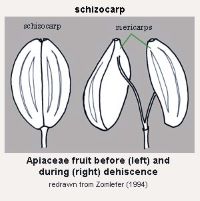 splitting into two indehiscentindehiscent:
splitting into two indehiscentindehiscent:
not opening on its own, as in a fruit
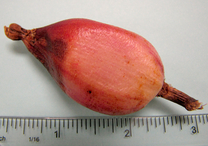 or dehiscentdehiscent:
or dehiscentdehiscent:
(v. dehisce) splitting open at maturity to release contents (of a fruit)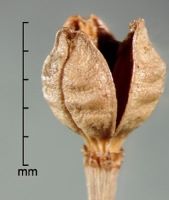 mericarps nutletsnutlet:
mericarps nutletsnutlet:
˜achene
, coccicoccus:
fruitlets, derived from a schizocarpous gynoecium, opening along their ventral sutures and sometimes the dorsal sutures as a result of their separation from one another or from a central axis (Spjut 1994, slight modification)
, or berriesberry:
an indehiscent, fleshy fruit with one or a few to many seeds. The flesh may be homogenous throughout. Or, if the outer part is hard, firm, or leathery, referred to as an hesperidium. Septa are present in some, and the seeds may be arillate or with a fleshy testa.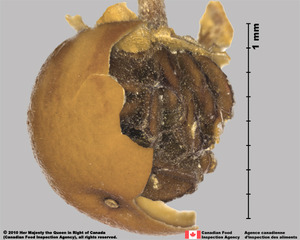 ). Fruits 2–180 mm long, variable in shape, often subglobosesubglobose:
). Fruits 2–180 mm long, variable in shape, often subglobosesubglobose:
3D shape—almost globose
to ellipsoidellipsoid:
3D shape—elliptic
, usually tereteterete:
approximately circular in cross section; width and thickness approximately equal
 in transection, sometimes compressedcompressed:
in transection, sometimes compressedcompressed:
flattened; in grasses, used to denote compression (not necessarily flattened) either laterally or dorsiventrally
or flattened. Fruits sometimes beakedbeak:
a usually firm, terminal appendage, sometimes tapered or winged, if winged with 4–8 wings, with one to many seeds, often crowned by persistent, sometimes accrescentaccrescent:
or winged, if winged with 4–8 wings, with one to many seeds, often crowned by persistent, sometimes accrescentaccrescent:
growing continuously
, calyxcalyx:
the outer whorl of the perianth; all the sepals of a flower . Pericarppericarp:
. Pericarppericarp:
fruit wall or fruit coat
black, blue, purple, brown, green, gray, red, orange, yellow, or white, shinyshiny:
uniformly reflecting a high proportion of incident light at all angles or dulldull:
or dulldull:
reflecting only a low proportion of incident light, with no apparent sheen .
.
BerriesBerry:
an indehiscent, fleshy fruit with one or a few to many seeds. The flesh may be homogenous throughout. Or, if the outer part is hard, firm, or leathery, referred to as an hesperidium. Septa are present in some, and the seeds may be arillate or with a fleshy testa. and drupesdrupe:
and drupesdrupe:
(indehiscent drupe) a fleshy, indehiscent fruit with one more hard pits enclosing seeds, derived from single, superior, simple or compound ovary; (dehiscent drupe) a fruit with a dry or fibrous to fleshy or leathery outer husk that early to tardily breaks apart (or opens), exposing one or more nutlike pits enclosing the seeds usually fleshy, sometimes leatheryleathery:
usually fleshy, sometimes leatheryleathery:
texture—moderately thick, tough, and very pliable
or woodywoody:
texture—consisting mainly of indurate lignified tissues, characteristic of or resembling wood
, rarely spongyspongy:
soft, light, discontinuous but cohesive, and somewhat resilient
or corkycorky:
firm, relatively light, discontinuous but strongly cohesive, and resilient
. PyrenesPyrene:
the hard inner portion of a drupe, consisting of a bony endocarp and an enclosed seed
cartilaginouscartilaginous:
texture—firm, dense, tough, somewhat pliable, and resilient, like cartilage
or bonybony:
very hard and rather brittle, like bone
, sometimes paperypapery:
texture—papyraceous, chartaceous; very thin, pliable, and readily torn; like paper
. CapsulesCapsule:
a dry, dehiscent fruit derived from a compound ovary and schizocarpsschizocarp:
and schizocarpsschizocarp:
usually dry fruit splitting between two or more locules to form distinct, indehiscent, usually one seeded segments; fruit derived from a single, superior or inferior, compound ovary; compare to mericarp usually chartaceouschartaceous:
usually chartaceouschartaceous:
papery, papyraceous
to woodywoody:
texture—consisting mainly of indurate lignified tissues, characteristic of or resembling wood
, sometimes cartilaginouscartilaginous:
texture—firm, dense, tough, somewhat pliable, and resilient, like cartilage
or leatheryleathery:
texture—moderately thick, tough, and very pliable
, rarely membranousmembranous:
texture—extremely thin, pliable, and fairly tough
or bonybony:
very hard and rather brittle, like bone
. Fruits, all types, glabrousglabrous:
without hairs
or less frequently pubescentpubescent:
surface relief—bearing hairs
, if pubescentpubescent:
surface relief—bearing hairs
usually with short, scattered hairs, smooth or lenticellate, groovedgrooved:
surface relief—linear depressions that may be single or form a series of grooves over the surface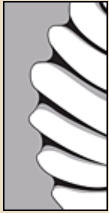 (pyrenespyrene:
(pyrenespyrene:
the hard inner portion of a drupe, consisting of a bony endocarp and an enclosed seed
), ridgedridged:
surface relief—raised, thick ridges, sharp edged or rounded, usually in a series that may cover the entire surface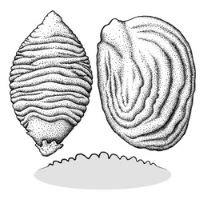 , wartywarty:
, wartywarty:
surface relief—distinct, rounded projections that are large relative to the fruit size; tuberculate, verrucose , or pustulatepustular:
, or pustulatepustular:
surface relief—with small blisters or pustules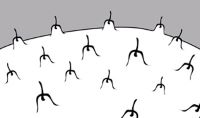 .
.
Seeds globoseglobose:
3D shape—more or less spherical to angularangular:
to angularangular:
2D shape—having sides that meet at acute or obtuse angles
, with or without fold between cotyledons and hypocotyl-radicle, sometimes notched, tereteterete:
approximately circular in cross section; width and thickness approximately equal
 , compressedcompressed:
, compressedcompressed:
flattened; in grasses, used to denote compression (not necessarily flattened) either laterally or dorsiventrally
, or flattened, 0.1–25 mm long. Sometimes marginally winged (narrow or broad), often paperypapery:
texture—papyraceous, chartaceous; very thin, pliable, and readily torn; like paper
, winged at one or both ends, or rarely caudatecaudate:
tapering to a long, tail-like appendage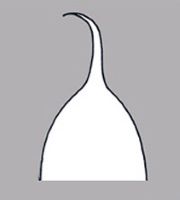 . ArilsAril:
. ArilsAril:
(broad sense) appendicular structure that wholly or partly envelops a seed and is produced from or a modification of the funicle, raphe, or outer integument; usually fleshy or pulpy, sometimes spongy or tufted-capillate, often brightly colored or aril-like structures sometimes present (Cephalanthus, Leptodermis, Shaferocharis, Spermacoce), if present usually white. Seed coat brown or black, membranousmembranous:
or aril-like structures sometimes present (Cephalanthus, Leptodermis, Shaferocharis, Spermacoce), if present usually white. Seed coat brown or black, membranousmembranous:
texture—extremely thin, pliable, and fairly tough
or leatheryleathery:
texture—moderately thick, tough, and very pliable
, glabrousglabrous:
without hairs
or sometimes pubescentpubescent:
surface relief—bearing hairs
(comose trichomestrichome:
a hair or hairlike outgrowth of the epidermis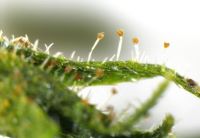 , Hillia), smooth or groovedgrooved:
, Hillia), smooth or groovedgrooved:
surface relief—linear depressions that may be single or form a series of grooves over the surface (often single deep groove), striatestriate:
(often single deep groove), striatestriate:
surface relief—having fine, parallel lines, grooves or ridges , pittedpitted:
, pittedpitted:
surface relief—surface with small depressions in which the areas between the hollows do not take on the appearance of a true reticular net , wartywarty:
, wartywarty:
surface relief—distinct, rounded projections that are large relative to the fruit size; tuberculate, verrucose , reticulatereticulate:
, reticulatereticulate:
surface relief—netted, raised walls or concave grooves forming a net-like surface pattern with flat, concave, or convex interspaces , wrinkledwrinkled:
, wrinkledwrinkled:
surface relief—shallow, irregular folds and furrows covering the surface; appearing overall though crumpled and then spread out , or papillosepapillate:
, or papillosepapillate:
surface relief—bearing minute, distinct, broad-based projections, tapering to a rounded apex (often hairy). Seeds sometimes embedded in fleshy or mucilaginousmucilaginous:
(often hairy). Seeds sometimes embedded in fleshy or mucilaginousmucilaginous:
resembling mucilage; moist and sticky
pulp. HilaHilum:
on seeds, the scar indicating where the funiculus was attached; on grass caryopses, the scar visible on the outer fruit surface revealing where the seed is attached on the inner fruit wall surface; or in Asteraceae cypselae, the scar visible on the outer fruit wall revealing where the fruit was attached to the receptacle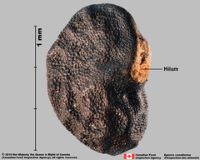 , if present and conspicuous, may be linearlinear:
, if present and conspicuous, may be linearlinear:
(shape) long, narrow, and uniform in width; (of embryo) embryo is straight and much longer than wide to broad, deeply concave, or comma-shaped.
to broad, deeply concave, or comma-shaped.
Embryo well developed, completely to partially filling seed coat, axileaxile:
on or of the axis
and centric, foliatefoliate:
appearing leaf-like
or conicalconical:
3D shape—cone-shaped, with the point of attachment at the broad end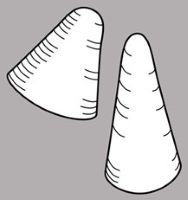 , straight to curvedcurved:
, straight to curvedcurved:
(of embryo) linear embryo is curved into an arch or horseshoe with the ends far apart . Cotyledons spatulatespatulate:
. Cotyledons spatulatespatulate:
2D shape—like a spatula; rounded at the apex, with base long and tapered; (of embryo) embryo is straight and axile and centric with the cotyledons expanded to form the shape of a spatula or spoon; (of cotyledons) cotyledons expanded and wider than the stalk but not invested into the stalk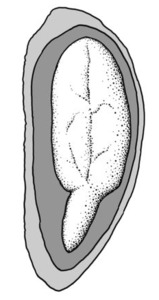 or investinginvesting:
or investinginvesting:
(of embryo) embryo is nearly or completely filling seed coat, straight, and axile and centric with spatulate cotyledons and covering the stalk for at least half its length; (of cotyledons) cotyledons spatulate and covering the stalk for at least half its length
, 0.1 to 0.9 times the length of embryo, thin, foliaceous or not, flat or convoluted, oblongoblong:
2D shape—much longer than broad with nearly parallel sides, corners are rounded , ovateovate:
, ovateovate:
2D shape—egg-shaped in outline, widest point is towards one end of the organ, the other end tapers gradually, attachment at or near the broad end (compare obovate, ovoid)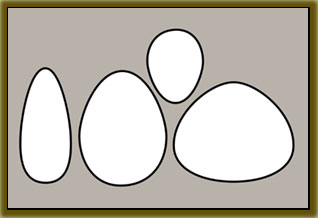 , cordatecordate:
, cordatecordate:
2D shape—heart-shaped, with attachment at or near the broad end (compare obcordate)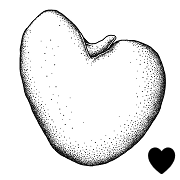 , or orbicularorbicular:
, or orbicularorbicular:
2D shape—circular in outline, 3D shape—globose
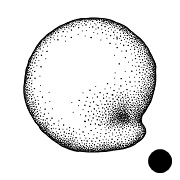 .
.
Endosperm usually copious, soft or hard fleshy, smooth or ruminateruminate:
testa or seed coat folded into the endosperm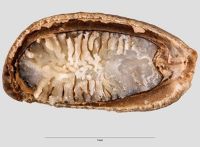 , rarely scanty or absent.
, rarely scanty or absent.
Can be a weed in uplands, grasslands, gardens, and forests. It spreads by seed reproduction and sometimes creeping stem propagation.
Noxious Weeds: USA Federal Noxious Weed List, terrestrial, Spermacoce alata Aublet.
Federal Noxious Weed Disseminules of the US tool provides a description and images of this species.
| Fruit | |
| Type | capsulecapsule: a dry, dehiscent fruit derived from a compound ovary  , drupedrupe: , drupedrupe:(indehiscent drupe) a fleshy, indehiscent fruit with one more hard pits enclosing seeds, derived from single, superior, simple or compound ovary; (dehiscent drupe) a fruit with a dry or fibrous to fleshy or leathery outer husk that early to tardily breaks apart (or opens), exposing one or more nutlike pits enclosing the seeds  , berryberry: , berryberry:an indehiscent, fleshy fruit with one or a few to many seeds. The flesh may be homogenous throughout. Or, if the outer part is hard, firm, or leathery, referred to as an hesperidium. Septa are present in some, and the seeds may be arillate or with a fleshy testa.  , schizocarpschizocarp: , schizocarpschizocarp:usually dry fruit splitting between two or more locules to form distinct, indehiscent, usually one seeded segments; fruit derived from a single, superior or inferior, compound ovary; compare to mericarp  splitting into 2 indehiscentindehiscent: splitting into 2 indehiscentindehiscent:not opening on its own, as in a fruit  or dehiscentdehiscent: or dehiscentdehiscent:(v. dehisce) splitting open at maturity to release contents (of a fruit)  mericarps, rarely samarasamara: mericarps, rarely samarasamara:a winged, indehiscent, dry fruit containing a single (rarely two) seed(s)  or aggregateaggregate: or aggregateaggregate:fruit formed from a single flower with carpels several and distinct  of achenesachene: of achenesachene:a dry, indehiscent, one-seeded fruit, with seed attached to pericarp at a single point, derived from a single, superior, simple or compound, one-loculed ovary  or drupeletsdrupelet: or drupeletsdrupelet:one drupe of a fruit with multiple drupes, as in blackberries |
| Size range | 2–180 mm long |
| Shape(s) | subglobosesubglobose: 3D shape—almost globose , hemisphericalhemispherical: 2D shape—shaped like half a sphere , cupuliform, ellipsoidalellipsoid: 3D shape—elliptic , oblongoblong: 2D shape—much longer than broad with nearly parallel sides, corners are rounded  , fusiformfusiform: , fusiformfusiform:spindle-shaped; broadest at the middle and tapering at both ends 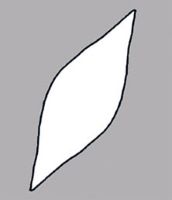 , ovoidovoid: , ovoidovoid:3D shape—ovate  , cylindricalcylindrical: , cylindricalcylindrical:3D shape—a cylinder, with parallel sides and a circular cross-section; tubular or rod-shaped , conicalconical: 3D shape—cone-shaped, with the point of attachment at the broad end  , wedge-shapedwedge-shaped: , wedge-shapedwedge-shaped:2D shape—triangular and tapering to a point at the base 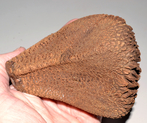 , didymousdidymous: , didymousdidymous:3D shape—paired, usually inflated and appears as two globose to ovoid halves pressed together , angledangular: 2D shape—having sides that meet at acute or obtuse angles , rarely mitriform or ob cordiformcordiform: 3D shape—heart-shaped |
| Texture | paperypapery: texture—papyraceous, chartaceous; very thin, pliable, and readily torn; like paper , leatheryleathery: texture—moderately thick, tough, and very pliable , woodywoody: texture—consisting mainly of indurate lignified tissues, characteristic of or resembling wood , cartilaginouscartilaginous: texture—firm, dense, tough, somewhat pliable, and resilient, like cartilage , membranousmembranous: texture—extremely thin, pliable, and fairly tough , bonybony: very hard and rather brittle, like bone , rarely spongyspongy: soft, light, discontinuous but cohesive, and somewhat resilient or corkycorky: firm, relatively light, discontinuous but strongly cohesive, and resilient |
| Surface relief | smooth, lenticellate, groovedgrooved: surface relief—linear depressions that may be single or form a series of grooves over the surface  (pyrenespyrene: (pyrenespyrene:the hard inner portion of a drupe, consisting of a bony endocarp and an enclosed seed ), ridgedridged: surface relief—raised, thick ridges, sharp edged or rounded, usually in a series that may cover the entire surface  , wartywarty: , wartywarty:surface relief—distinct, rounded projections that are large relative to the fruit size; tuberculate, verrucose  , pustulatepustular: , pustulatepustular:surface relief—with small blisters or pustules  |
| Color(s) | black, blue, purple, brown, green, gray, red, orange, yellow, white |
| Unique features | Fruits variable but often splitting into two segments with each fruit with a flattened or concave face and crowned by persistent calyxcalyx: the outer whorl of the perianth; all the sepals of a flower  . . |
| Seed | |
| Size range | 0.1–25 mm long |
| Shape(s) | globoseglobose: 3D shape—more or less spherical  , plano-convexplano-convex: , plano-convexplano-convex:2D or 3D shape—flat on one side, convex on the other 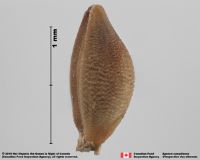 , ellipsoidalellipsoid: , ellipsoidalellipsoid:3D shape—elliptic , lens-shapedlens-shaped: 2D shape—round and flattened with two curved (convex) surfaces , ovoidovoid: 3D shape—ovate  , oblongoblong: , oblongoblong:2D shape—much longer than broad with nearly parallel sides, corners are rounded  , lanceoloidlanceoloid: , lanceoloidlanceoloid:3D shape—lanceolate , or angledangular: 2D shape—having sides that meet at acute or obtuse angles (including cuboidal), rarely sigmoid or fusiformfusiform: spindle-shaped; broadest at the middle and tapering at both ends  (Dialypetalanthus fucescens) or hippocrepiformhippocrepiform: (Dialypetalanthus fucescens) or hippocrepiformhippocrepiform:3D shape—horseshoe-shaped (Theligonum) |
| Surface relief | smooth, groovedgrooved: surface relief—linear depressions that may be single or form a series of grooves over the surface  (deeply so), striatestriate: (deeply so), striatestriate:surface relief—having fine, parallel lines, grooves or ridges  , pittedpitted: , pittedpitted:surface relief—surface with small depressions in which the areas between the hollows do not take on the appearance of a true reticular net  , wartywarty: , wartywarty:surface relief—distinct, rounded projections that are large relative to the fruit size; tuberculate, verrucose  , reticulatereticulate: , reticulatereticulate:surface relief—netted, raised walls or concave grooves forming a net-like surface pattern with flat, concave, or convex interspaces  , wrinkledwrinkled: , wrinkledwrinkled:surface relief—shallow, irregular folds and furrows covering the surface; appearing overall though crumpled and then spread out  , papillosepapillate: , papillosepapillate:surface relief—bearing minute, distinct, broad-based projections, tapering to a rounded apex  (often hairy), and or/or marginally winged (often hairy), and or/or marginally winged |
| Color(s) | black, brown |
| Unique features | Seeds vary greatly in all traits. Some seeds with ruminateruminate: testa or seed coat folded into the endosperm  endosperm. endosperm. |
| Other | |
| Embryo | well developed, completely to partially filling seed coat, axileaxile: on or of the axis and centric, foliatefoliate: appearing leaf-like or conicalconical: 3D shape—cone-shaped, with the point of attachment at the broad end  , straight to curvedcurved: , straight to curvedcurved:(of embryo) linear embryo is curved into an arch or horseshoe with the ends far apart  . Cotyledons spatulatespatulate: . Cotyledons spatulatespatulate:2D shape—like a spatula; rounded at the apex, with base long and tapered; (of embryo) embryo is straight and axile and centric with the cotyledons expanded to form the shape of a spatula or spoon; (of cotyledons) cotyledons expanded and wider than the stalk but not invested into the stalk  or investinginvesting: or investinginvesting:(of embryo) embryo is nearly or completely filling seed coat, straight, and axile and centric with spatulate cotyledons and covering the stalk for at least half its length; (of cotyledons) cotyledons spatulate and covering the stalk for at least half its length , 0.1 to 0.9 times the length of embryo, thin, foliaceous or not, flat or convoluted, oblongoblong: 2D shape—much longer than broad with nearly parallel sides, corners are rounded  , ovateovate: , ovateovate:2D shape—egg-shaped in outline, widest point is towards one end of the organ, the other end tapers gradually, attachment at or near the broad end (compare obovate, ovoid)  , cordatecordate: , cordatecordate:2D shape—heart-shaped, with attachment at or near the broad end (compare obcordate)  , or orbicularorbicular: , or orbicularorbicular:2D shape—circular in outline, 3D shape—globose  . . |
| Nutritive tissue | endosperm usually copious, soft- or hard-fleshy, smooth or ruminateruminate: testa or seed coat folded into the endosperm  , rarely scanty or absent , rarely scanty or absent |
Worldwide.
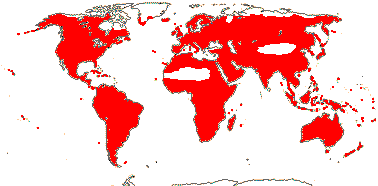
Distribution map courtesy of Angiosperm Phylogeny Website.
Eriksson and Bremer 1991Eriksson and Bremer 1991:
Eriksson O. and Bremer B. 1991. Fruit characteristics, life forms, and species richness in the plant family Rubiaceae. The American Naturalist 138: 751&-761.; Goldberg 1986Goldberg 1986:
Goldberg A. 1986. Classification, Evolution, and Phylogeny of the Families of Dicotyledons. Smithsonian Contributions to Botany. pp 314. https://doi.org/10.5479/si.0081024X.58; Kirkbride et al. 2006Kirkbride et al. 2006:
Kirkbride JH, Jr, Gunn CR, and Dallwitz MJ. 2006. Family guide for fruits and seeds, vers. 1.0. Accessed September 2020-January 2022. URL: https://nt.ars-grin.gov/seedsfruits/keys/frsdfam/index.cfm .; Noxious Weed Regulations 2020Noxious Weed Regulations 2020:
Noxious Weed Regulations. 2020. 7 C.F.R. sect; 360.100-360.600.; Takhtajan 2009Takhtajan 2009:
Takhtajan A. 2009. Flowering plants: Second edition. Springer Nature, Switzerland. 871 pp.; Taylor 2021+Taylor 2021+:
Taylor CM. 2021+ [continuously updated]. Rubiaceae. In: Taylor CM and collaborators, Rubiaceae Project. Tropicos.org. Missouri Botanical Garden. http://legacy.tropicos.org/Name/40029303?projectid=34. Accessed March 2023.; USDA 1980USDA 1980:
United States Dept. of Agriculture (USDA). 1980. Major weed family identification guide. Hyattsville Md, United States
*The number of genera and species is based on Christenhusz and Byng 2016Christenhusz and Byng 2016:
Christenhusz MJM and Byng JW. 2016. The number of known plant species in the world and its annual increase. Phytotaxa 261 (3): 201-217. https://doi.org/10.11646/phytotaxa.261.3.1, which may differ from the number of genera in GRIN-Global.